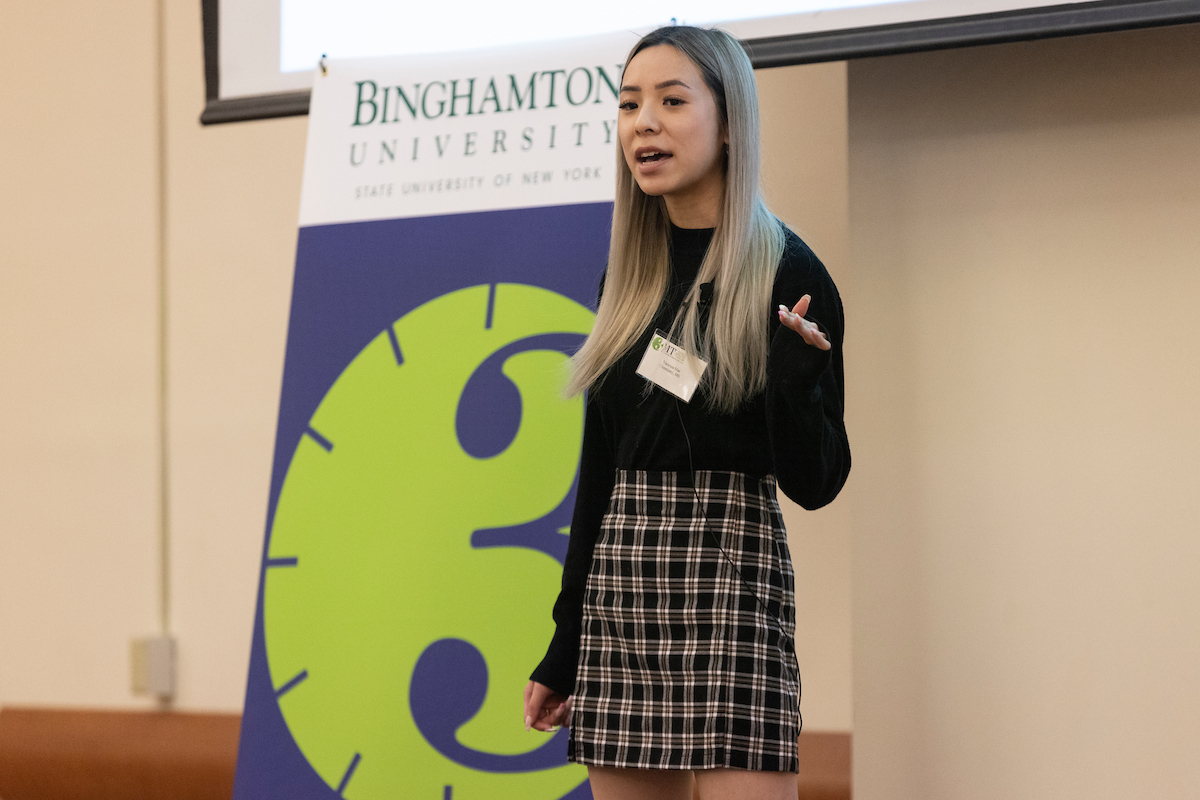Elevator pitch: Competition challenges grad students to explain research in 3 minutes

Graduate students spend long months, even years, conducting research. As they develop into experts in their field, they tease out intricate complexities in topics that outsiders rarely encounter, much less understand.
Try to condense that research and expertise into three minutes or less. (Even TED Talks can take up to 18 minutes.)
“I’m somebody who sometimes struggles with trying to express what my research is to people who aren’t in my field. I felt like it was a challenge I needed to take up,” said Victoria Oladosu, a doctoral candidate in biochemistry and the second-place finisher in this year’s 3 Minute Thesis (3MT) competition. “It was a very good experience.”
Eight competitors boiled their research down to the essentials during the third annual competition, hosted by Binghamton University and the Graduate School.
This year, Harpur College students swept all three places. Vanessa Mai, who was the only master’s student to compete, won both first place and the People’s Choice Award for her presentation in chemistry, “Identify if Your Skincare Routine is the Problem.” Oladosu came in second for “Divide and Conquer: Ending the War Between Bacterial Communities and Antibiotics,” while Mert Can Bayar, a PhD student in political science, netted a third-place finish for “Politics of Good and Evil: Conspiracy Theories’ Role in Democratic Erosion.”
Most of the competitors met weekly with Ellen Tilden, associate director for academic and graduate student affairs and director of the Graduate Community of Scholars, to prepare for the competition.
“I was so impressed with their passion for their research and dedication to participating in this year’s 3MT Competition,” she said. “I hope they can all take something positive away from this experience.”
Explaining complexity
Boiling down months and even years of research into three insightful minutes is no easy feat, participants said, although multiple drafts help. Finding a way to relate to the audience is also key.
“STEM topics can be a little intimidating. But I felt that my topic — identifying contaminants in skincare products — is relevant to everyone because we all use personal care products,” Mai said.
In her research, Mai analyzes the role of common ingredients in skincare products in environmental pollution. To that end, she uses Raman spectroscopy imaging, which relies on the interaction of light with a chemical bond within a given material. Each chemical has a unique set of spectral fingerprints that allows scientists to see exactly what a material contains — such as particular microplastics or metal oxides within skincare products.
Her presentation focused on three common contaminants: polyethylene, polymethylmethacrylate and titanium dioxide. The first two are microplastics commonly found in moisturizers and sunscreen, which prove problematic because they don’t biodegrade. The latter is a metal oxide found in virtually all sunscreens, where it is used to reflect UV light. Studies have shown that these substances can affect aquatic environments and the creatures that live in them, she said.
To prevent harm to the environment, consumers should be cautious about the products they’re purchasing and select those with more eco-friendly ingredients, Mai said. The website beatthemicrobead.org has a database of products that consumers can check.
In her research, Oladosu is currently investigating how bacterial communities develop tolerance to antibiotics. Bacterial communities known as biofilms are found everywhere; they’re a major component of tooth plaque, for example, she said. Antibiotic resistance, too, is widespread and a growing problem for anyone suffering from pneumonia to cystic fibrosis patients with lung infections.
Oladosu’s research focuses on a particular protein that appears to make bacterial communities more tolerant of antibiotic treatment. Figuring out this protein’s role is a necessary first step to potentially creating more effective treatment for infection in the future.
“My research is so specific and complicated that I wasn’t sure I could put it into a very short presentation,” she said. “But the effort actually helped me find a larger perspective and why I’m spending so many hours doing what I do.”
